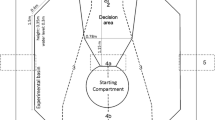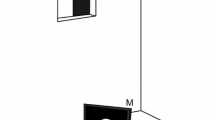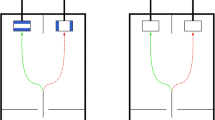Abstract
The nature of spatial information used for memorizing and recalling places is largely unclear. Earlier studies tested integration of geometric and feature information mostly during reorientation in artificial environments without including time as a memory-critical component. Here, we tested a harbour seal in a delayed matching-to-sample task (DMTS) in a familiar environment under two spatial multiple-choice conditions. The feature condition consisted of a DMTS task with four comparison stimuli presented on fixed positions in a classic matching apparatus and was designed to make stimulus features the most prominent information. The landscape condition consisted of a DMTS task in a familiar environment with four places marked by comparison stimuli and allowed the use of all available spatial information including geometrical and feature information. The seal’s performance was impaired by delays of 3, 6, 9 or 12 s only in the feature condition; a delay of 12 s resulted in chance level performance. Replacing the comparison stimuli at the apparatus with identical spheres resulted in impaired performance. Performance in the landscape condition was impaired neither by delays nor by replacing comparison stimuli with spheres. Landscape information obviously was encoded redundantly and could be recalled more reliably and longer than feature information, which reveals feature information to be a less valuable type of spatial information for memorizing and recalling places.



Similar content being viewed by others
References
Benhamou S, Poucet B (1998) Landmark use by navigating rats (Rattus norvegicus)-contrasting geometric and featural information. J Comp Psychol 112:317–322
Biegler R, Morris RGM (1996) Landmark stability: studies exploring whether the perceived stability of the environment influences spatial representation. J Exp Biol 199:187–193
Brodbeck DR (1994) Memory for spatial and local cues: a comparison of a storing and a nonstoring species. Anim Learn Behav 22:119–133
Brodin A (2005) Mechanisms of cache retrieval in long-term hoarding birds. J Ethol 23:77–83
Chamizo VD (2002) Spatial learning: conditions and basic effects. 16 Psícologica 23:33–57
Cheng K (1986) A purely geometric module in the rat’s spatial representation. Cognition 23:149–178
Cook RG, Tauro TL (1999) Object-goal positioning influences spatial representation in rats. Anim Cogn 2:55–62
Deipolyi A, Santos L, Hauser MD (2001) The role of landmarks in cotton-top tamarin spatial foraging: evidence for geometric and non-geometric features. Anim Cogn 4:99–108
Fiset S, Doré FY (2006) Duration of cats’ (Felis catus) working memory for disappearing objects. Anim Cogn 9:62–70
Gallistel CR (1990) The organisation of learning. MIT Press, Cambridge
Gallistel CR, Cheng K (1985) A modular sense of place? Behav Brain Sci 8:11–12
Gellermann LW (1933) Chance orders of alternating stimuli in visual discrimination experiments. J Genet Psychol 42:206–208
Gouteux S, Spelke ES (2001) Children’s use of geometry and landmarks to orient in open space. Cognition 81:119–148
Gouteux S, Thinus-Blanc C, Vauclair J (2001) Rhesus monkey use geometric and nongeometric information during a reorientation task. J Exp Psychol Gen 130:505–519
Gray ER, Bloomfield LL, Ferrey A, Spetch ML, Sturdy CB (2005) Spatial encoding in mountain chickadees: features overshadow geometry. Biol Lett 1:314–317
Hermer L (1997) Internally coherent spatial memories in a mammal. Neuroreport 8:1743–1747
Hermer L, Spelke ES (1994) A geometric process for spatial representation in young children. Nature 370:57–59
Hermer-Vazquez L, Spelke ES, Katsnelson AS (1999) Sources of flexibility in human cognition: dual task studies of space and language. Cognit Psychol 39:3–36
Horne PJ, Lowe CF (1996) On the origins of naming and other symbolic behavior. J Exp Anal Behav 65:185–241
Kamil AJ, Jones JJ (1997) The seed-storing corvid Clark’s nutcracker learns geometric relationships among landmarks. Nature 390:276–279
Kelly DM, Spetch ML, Heth CD (1998) Pigeons’ (Columba livia) encoding of geometric and featural properties of a spatial environment. J Comp Psychol 112:259–269
Kowalewsky S, Mauck B, Dambach M, Dehnhardt G (2006) High olfactory sensitivity for dimethyl sulphide in harbour seals. Biol Lett 2:106–109
Margules J, Gallistel CR (1988) Heading in the rat: determination by environmental shape. Anim Learn Behav 16:404–410
Mauck B, Dehnhardt G (1997) Mental rotation in a California sea lion (Zalophus californianus). J Exp Biol 200:1309–1326
Mauck B, Dehnhardt G (2005) Identity concept formation during visual multiple-choice matching in a harbor seal (Phoca vitulina). Learn Behav 33:428–436
Mauck B, Brown D, Schlosser W, Schaeffel F, Dehnhardt G (2005) How a harbor seal sees the night sky. Mar Mamm Sci 21:646–656
Mobley JR Jr, Helweg DA (1990) Visual ecology and cognition in cetaceans. In: Thomas J, Kastelein R (eds) Sensory abilities of cetaceans. Plenum Press, New York, pp 519–536
O’Keefe J, Nadel L (1978) The hippocampus as a cognitive map. Clarendon Press, Oxford
Pack AA, Herman LM, Roitblat HL (1991) Generalization of visual matching and delayed matching by a California sea lion (Zalophus californianus). Anim Learn Behav 19:37–48
Pearce JM, Ward-Robinson L, Good M, Fussel C, Aydin A (2001) Influence of a beacon on spatial learning based on the shape of the test environment. J Exp Psychol Anim Behav Process 27:329–344
Poucet B (1993) Spatial cognitive maps in animals: new hypotheses on their structure and neural mechanisms. Psychol Rev 100:163–182
Renouf D (1991) Sensory reception and processing in Phocidae and Otariidae. In: Renouf D (ed) The behaviour of pinnipeds. Chapman & Hall Ltd, London, pp 345–394
Renouf D, Gaborko L (1988) Spatial matching to sample in habour seals (Phoca vitulina). Biol Behav 13:73–81
Renouf D, Gaborko L (1989) Spatial and visual rule use by harbour seals (Phoca vitulina). Biol Behav 14:169–181
Schusterman RJ (1981) Behavioral capabilities of seals and sea lions. A review of their hearing, visual, learning and diving skills. Psychol Rec 31:125–143
Schusterman RJ, Kastak D (1993) A California sea lion (Zalophus californianus) is capable of forming equivalence relations. Psychol Rec 43:823–829
Schusterman RJ, Kastak D (2002) Problem solving and memory. In: Hoelzel R (ed) Marine mammals: an evolutionary approach. Blackwell, Oxford, pp 371–387
Schusterman RJ, Kastak D, Reichmuth C (1997) What’s in a name? Equivalence by any other name would smell as sweet. J Exp Anal Behav 68:252–258
Sherry DF, Duff SJ (1996) Behavioural and neural bases of orientation in food-storing birds. J Exp Biol 199:165–172
Sovrano VA, Bisazza A, Vallortigara G (2002) Modularity and spatial reorientation in a simple mind: encoding of geometric and nongeometric properties of a spatial environment by fish. Cognition 85:B51–B59
Stich K-P, Dehnhardt G, Mauck B (2003) Mental rotation of perspective stimuli in a California sea lion (Zalophus californianus). Brain Behav Evol 61:102–112
Sticken J, Dehnhardt G (2000) Salinity discrimination in harbour seals: a sensory basis for spatial orientation in the marine environment? Naturwissenschaften 87:499–502
Thinus-Blanc C (1996) Animal spatial cognition. Behavioral and neural approaches. World Scientific Publishing Co., Singapore
Thompson PM, Miller D (1990) Summer foraging activity and movements of radio-tagged common seals (Phoca vitulina L.) in the Moray Firth, Scotland. J Appl Ecol 27:492–501
Vargas JP, López JC, Salas C, Thinus-Blanc C (2004) Encoding of geometric and featural spatial information by goldfish (Carassius auratus). J Comp Psychol 118:206–216
Vlasak A (2006) Global and local spatial landmarks: their role during foraging by Columbian ground squirrels (Spermophilus columbianus). Anim Cogn 9:71–80
Wang RF, Spelke ES (2002) Human spatial representation: insights from animals. Trends Cogn Sci 6
Wang RF, Hermer L, Spelke ES (1999) Mechanisms of reorientation and object localization by children: a comparison with rats. Behav Neurosci 113:475–485
Watanabe S (2005) Strategies of spatial learning for food storing in scrub jays. J Ethol 23:181–187
Acknowledgments
The experimental animal was treated in accordance with the official German regulations for research on animals. We thank the Zoo Cologne for the support during this study. The VolkswagenStiftung and the Deutsche Forschungsgemeinschaft supported this study by grants to G.D.
Author information
Authors and Affiliations
Corresponding author
Rights and permissions
About this article
Cite this article
Mauck, B., Dehnhardt, G. Spatial multiple-choice matching in a harbour seal (Phoca vitulina): differential encoding of landscape versus local feature information?. Anim Cogn 10, 397–405 (2007). https://doi.org/10.1007/s10071-007-0074-7
Received:
Revised:
Accepted:
Published:
Issue Date:
DOI: https://doi.org/10.1007/s10071-007-0074-7




